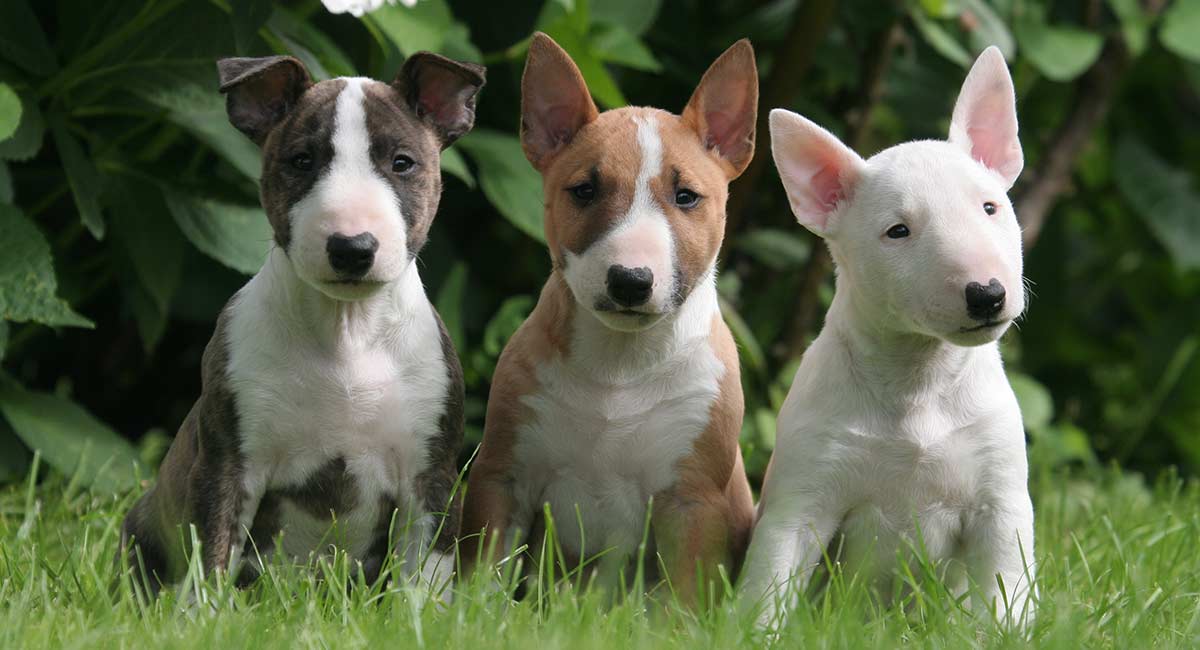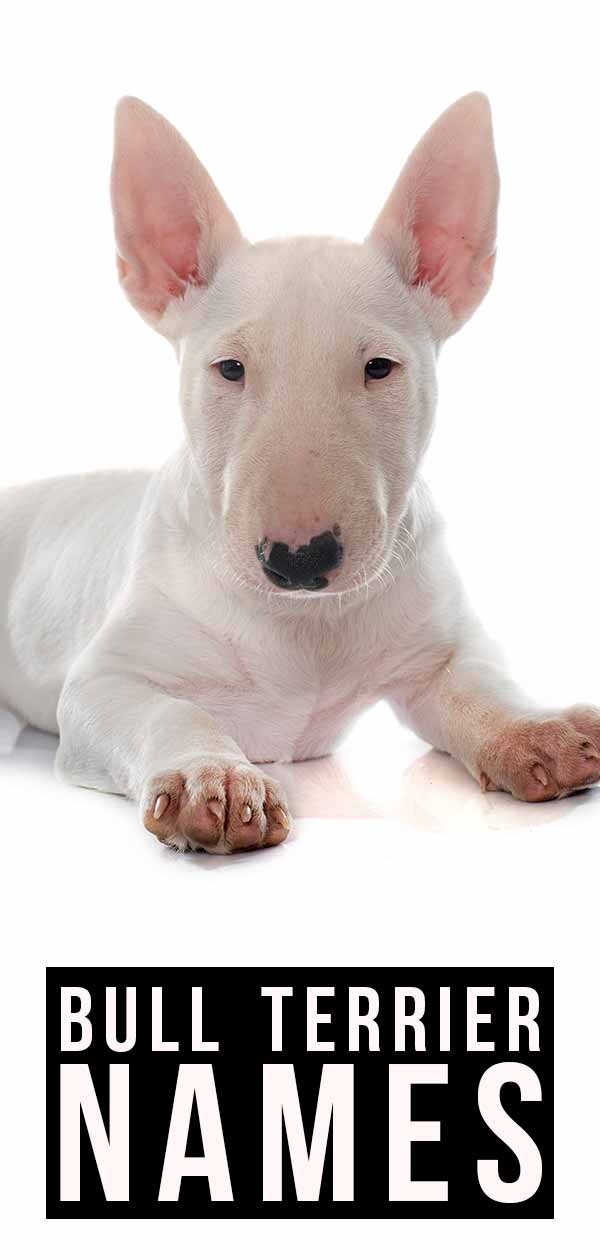
Bull Terriers are a unique breed that have many characteristics perfect for naming inspiration. If you’re ready to bring home your very own Bull Terrier puppy, you’ll definitely want to take a look at our fantastic and comprehensive themed Bull Terrier names lists.
Contents
- Fun female Bull Terrier names
- Classic boy Bull Terrier names
- Rocking or relaxing ideas
- Creative inspiration
The Best Ideas
Deciding on a name for any new pet is a wonderful start to bonding with your new furry friend. Often, prospective pet parents see their pet and quickly think of a name inspired by their unique appearance and personality.
The Bull Terrier’s distinctiveness does not stop with their appearance. These dogs are generally energetic and strong, and have a personality that gives them an added twist. Clearly, this breed is unapologetically unique!
Female Bull Terrier names
Many of these names have roots in Old English and Middle English. In general, they evoke the image of their mid-nineteenth century career as a young gentleman’s companion dog. Some of these names will likely seem familiar, while others will look (and sound) a bit more foreign, even antiquated.
- Audrey
- Willow
- Lyla
- Nylah
- Marlee
- Wren
- Trixie
- Dana
- Kimber
- Briar
- Edith
- Elizabeth
- Wendy
- Wilfreda
- Luella
- Jemma
- Tayla
- Coralie
- Kyndall
- Jaida
- Laney
- Darlene
- Jenny
- Harleen
- Kourtney
- Aven
- Sydnee
- Tammy
- Mei
- Haileigh
- Heather
- Rubee
- Dawn
- Maryann
- Ashtyn
- Edwina
- Starla
- Goldie
- Leatrice
- Suelyn
- Jadira
- Waverly
- Mildred
- Primrose
- Udele
- Staci
- Perri
- Bayla
- Elvenia
- Diona
Male Bull Terrier names
Continuing our name ideas based on the Bull Terrier’s British background. Again, you will probably see some familiar names, along with many other unfamiliar (but still very appealing) names. Most of these names have an unmistakably distinguished sound and feel to them.
- Jackson
- Wyatt
- Landon
- Grayson
- Colton
- Alvin
- Sherman
- Grover
- Cooper
- Haywood
- Lancaster
- Sheffield
- Todd
- Howard
- Hart
- Hayden
- Kingston
- Stewart
- Everett
- Edward
- Steven
- Elton
- Tucker
- Whitaker
- Preston
- Graham
- Jasper
- Simon
- Remington
- Jack
- Corbin
- Tanner
- Clayton
- Trevor
- Oakley
- Brinley
- Edgar
- Radcliffe
- Lawson
- Hayes
- Skip
- Brock
- Sutton
- Woodrow
- Raylen
- Davis
- Bristol
- Clint
- Franklin
- Maceo
Cool Bull Terrier names
For this list, we will take our cue largely from characteristics such as the Bull Terrier’s aforementioned strength and speed. The resulting list is a combination of English-origin and popular, evergreen dog names that stand out as having a “cool” meaning or sound (often both)!
- Comet
- Speedy
- Hero
- Champ
- Stoney
- Ash
- Dev
- Free
- Arrow
- Skye
- Spirit
- Firey
- Power
- Bourne
- Twilight
- Diamante
- Vigor
- Dart
- Knoll
- Steele
- Rowdy
- Stormie
- Silvestra
- Shadow
- Slade
- Ransom
- Bev
- Flint
- Kipp
- Rusty
Cute Bull Terrier names
Our list of cute Bull Terrier names is packed with both names that have clear English origins and other common, popular ideas. While our previous cool names list focused on the Bull Terrier’s physical traits, here we take a more lighthearted approach.
Many of these names are tied to the Bull Terrier’s playful (even mischievous) nature. This approach results in a host of funny names for Bull Terriers. Most of these also lend themselves to good Bull Terrier puppy names as well as Miniature Bull Terrier names. Clearly, these cute monikers have many potential uses!
- Goofy
- Jester
- Laddie
- Eggo
- Mischief
- Tricky
- Zippy
- Joy
- Spot
- Joker
- Frolic
- Bouncy
- Binky
- Ivy
- Perky
- Prankster
- Rascal
- Loyal
- Sprite
- Bliss
- Daisy
- Darling
- Hope
- Dolly
- Sonny
- Buddy
- Merry
- Fern
- Blossom
- Misty
- Cookie
- Sunshine
- Clover
- Frisky
- Imp
- Bea
- Spring
- Baby
- Velvet
- Lady
Unique Bull Terrier names
Many of these potential names have clear meanings that make a statement, such as names related to social status and power. This is a tribute to the Bull Terrier’s previously mentioned time as a dog for nineteenth-century British gentlemen. We’ve also included some unisex names of English origin that we think have their own unique appeal.
- Royal
- Prince
- Liberty
- Duke
- Justice
- Blessing
- Empress
- Mistic
- Mercer
- Autumn
- Marigold
- Wisdom
- Bentlea
- Mercy
- Whimsy
- Queena
- Courtland
- Lovella
- Purity
- Allure
- Langleigh
- Journey
- Blakelee
- Sterling
- Chesney
- Carden
- Crystal
- Ashby
- Temperance
- Sapphire


Arienca says
I have a bully she is black and white her name is Eleanor we also call her Ellie And Varkie (pig)
Jane says
Ive had a Hattie, a Moomin, an Elsa and a Tess. If I get a boy next he will be Axel, Geezer or Dodger
Debra says
My mbt was named Cletis. Fit him to a T.
That bull terrier and pitbull lover says
I have two bull terriers a white one named Honky (Male) and a black white and brindle one named pebbles (female) and they are so cute and energetic.
Mark Mullis says
Going with the traditional English names: Winston was our first Bully. He lived to be almost 11. Dudley was our second Bully. He lived to be 13. And our most recent Bully was named Stanley (who we just lost 3 weeks ago). He lived to be between 15 and 16. Our next bully, if it is a male, will be Luka or Boris. The approximately 35-40 years I have spent with Bull Terriers has most assuredly made my life better in every way.
Heather says
I should add these… Von, Clint, Fritz and Heizenburgh!
Sandra Murphy says
My Bull terriers are amazing dogs. Theyre so loveable & loyal.
My 2 males are Ruben & Rocco.
My 3 females are Boo,kali & Jazz.
Khristal Prause says
Our Bullies names are Pancho (male) & Needles (girl)
jake satterfield says
list not accurate. could not find the name “Walter” anywhere. 2/10.
emily murphy says
i agree with this statement
Jenelle K says
me too.
Geraldine Campos says
me three.
Elias M-K says
me four
That bull terrier and pitbull lover says
Yeah they should edit and put walter
Billie J Howd says
my dogs name is JellyBean. Beanie for short.
ermdoggos says
ack i will definitely be naming my bull terrier Eggo
thats all i have to say
yea
Nerys says
I love bull terriers they are just so cute and well behaved dogs I knew one named Zoe but if I owned my own I would definitely propably name it if it was a boy Jasper or Carson for a girl maybe Lyra or karmen or taytum
Connie says
Additional Bull Terrier Names:
Rolo, Jasper, Radar, Otis, Astro